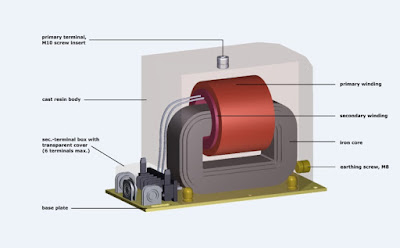Before going into the impact of Burden on the performance of a Potential transformer, we will discuss about Burden. The Burden of an Instrument Transformer is the rated Volt-Ampere loading which is permissible without errors exceeding the limits for a particular class of Instrument Transformer.
Now, we will discuss about errors in a Potential Transformer. There are two types of error in a Potential Transformer, Ratio Error and Phase Angle Error.
Ratio Error:
Transformation Ratio of a Potential Transformer varies with the operating condition and therefore the voltage induced in the secondary of a Potential Transformer will also vary. The error in secondary voltage of a Potential Transformer is defined as
% Ration Error = (Kn-R)×100/R
Where Kn = Rated primary voltage / Rated secondary voltage
R = Primary Voltage / Secondary Voltage
Phase Angle Error:
In an ideal Potential Transformer, there should not be any phase difference between the primary voltage and the secondary voltage reversed. But in a practical Potential Transformer there exists a phase difference between them.
The important thing to note that, Ratio error is of importance when we use PT for Protection purpose but when we use PT for Metering then both Ration and Phase Angle Error are important to consider.
Now we are on the stage to discuss the impact of Burden on the performance of a Potential Transformer.
Impact of Burden on the Performance of PT:
The effects of Burden on the performance of a Potential Transformer are as follows:
If we increase the Burden, the secondary as well as primary current will increase but as the primary voltage will remain constant (because primary of a PT is connected to the line), the secondary voltage will decrease. Therefore, the voltage ratio will increase. Thus we see that increasing the Burden, increases the Error in the Ratio. Also, as the power factor of the Burden reduces the transformation ratio of Potential Transformer increases.
PT accuracy performance changes linearly with burden and can be plotted as
Here RCF is Ratio Correction Factor, which is defined as defined as the factor that when multiplied by the potential transformer output will yield the correct result.
Mathematically,
RCF = Transformation Ratio/Nominal Ratio =R / Kn
The transformer nameplates show a “marked ratio” usually an even number, such as 20 to 1. The actual ratio of primary to secondary quantity may be slightly higher or lower than the marked value by an amount 1 called ratio error. For example, if the actual ratio is 20.2 to 1, then the RCF is 1.01 and the ratio error is 1%.
RCF = 20.2/20 = 1.01
So, % Ratio Error = (RCF-1)×100 = 1%


Thanks so much! The term "burden" is not that common in latam, so this was very handy!
RCF IS Kn/R, I THINK, INSTEAD OF R/Kn
You lost me at “ If we increase the Burden, the secondary as well as primary current will increase ”. I always thought that an increase in impedance would result in a decreased current. Where am I going wrong here?
I’ll go with Chanda on this*. 🙂